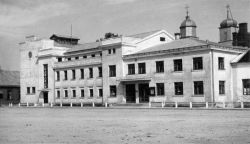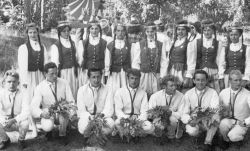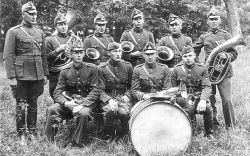That the Aizsargi built not armories but halls for hosting community and cultural events, financed by donations from the public, paints a far more representative picture of their mission than the sensational, false, and all-too-often repeated images of jack-booted fascists run amok.
Each county of Latvia had its own Aizsargi regiment, 19 in all. The Jēkabpils 4th Regiment was among the first to build a civic events hall.1 Jēkabpils was but one example, other halls being built in Madona, Vandzene parish, Valka, Malta, and the Talsi area.2 The Jēkabpils Aizsargu Nams hosted regimental activities and meetings and functioned as a cultural promotion and preservation center.3 Now the Jēkabpils Tautas Nams, "Jēkabpils Folk Hall," it is still in use today.
Sports and fitness
Continuing with Jēkabpils as our example, the photo at right is from their 1934 Sports and Fitness Festival.4 One of the goals of the Aizsargi was to promote mental and physical fitness, organizing sports clubs and fitness and sports exhibitions and contests. 1937 marked the first national Aizsargi Fitness and Folk Dancing Festival. By 1939, Aizsargi sports had grown to 30 sports clubs, 532 troops (as in scout "troops"), and more than 14,000 members.56
Cultural activities
Folk dancing
Folk dancing has had a long history in Latvia. In independent Latvia, the 1920's and 1930's marked active advancement of folk dancing. It was included in the school curriculum. Folk dancing performances were held in theatrical and open-air events. In 1932, all the Aizsargi regiments took up teaching of folk dancing in addition to their fitness activities. A large fitness and sports festival was held in 1939 to mark the 20th anniversary of the Aizsargi—4,000 athletes and folk dancers participated.
Latvian folk dancing representatives also took part in international congresses, festivals, gatherings: 1934 International Folk Dance Festival in Vienna, 1935 in London, the Paris World's Fair in 1937, and in 1939 the Third International Folk Dance Event in Stockholm.7
Folk singing
Folk singing has had a similarly long history in Latvia. Any organization of any note had—and still has—a choir. Where Americans have bowling, the Brits have darts, Latvians have singing. So it is unsurprising the Aizsargi sang as well. In Ugāle, for example, they founded a choir in 1929 which only two short years later was good enough to participate in the VII Latvian Song Festival. While its Aizsargi origins have passed into history, the choir survived half a century of Soviet occupation and is still active today, ninety-five years later.8
Below, a picture album9 of the Omuļi Aizsargi mixed choir, founded in 1923, still active in 1937. "Dikļi," the site of the song festival included in the album, has a significant place in Latvian choral history as the birthplace of Latvian song days and festivals. Priest, teacher, and writer Juris Neikens organized the first Latvian Song Day there one hundred and sixty years ago in 1864. The program cover notes that the 1939 festival commemorates the 75th anniversary of that festival.
Other activities
As the primary, if not only, venue for community events in rural areas, the Aizsargi hosted all sorts of theatrical, musical, and cultural activities, even hosting performances by the National Opera. Aizsargi chapters also had their own "orchestras," typically brass bands.
| 1 | Jēkabpils ziņas - Jēkabpils Laiks - Aicina saglabāt bijušā Aizsargu nama kultūrvēsturisko nozīmi, in Latvian |
| 2 | Brīvā Daugava, in Latvian |
| 3 | Gailīte, S. Jēkabpils. Rīga, Gandrs, 2002. page 37 |
| 4 | Zudusi Latvija, retrieved 31-March-2017] |
| 5 | Sporta pirmsākumi, retrieved 31-March-2017. |
| 6 | Jēkabpils 4.aizsargu pulka sporta svētki ( Stankevičs, V.), retrieved 31-March-2017. |
| 7 | Skolēnu deju svētki Latvijā: vēsturiskais, kvalitatīvais, mākslinieciskais aspekts, Prof. Dr. Rita Spalva. |
| 8 | Vienīgajam Ventspils novada korim – 85 gadi, retrieved 31-March-2017. |
| 9 | Omuļu koris, retrieved 01-April-2017 |
External sites
- laukums.jekabpils.lv/
, in Latvian - www.bdaugava.lv, in Latvian
- www.tda-zile.lv/
par-mums/ , in Latvianvesture/







